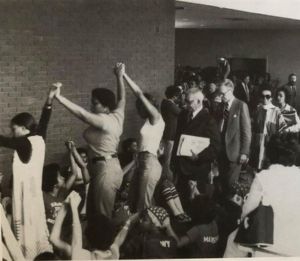 On March 25, 2024, more than 100 students, staff, faculty and alumnae gathered in the Camille Cosby Fine Arts Center auditorium to view never-before-seen footage from the Spelman College Protest of 1976.
On March 25, 2024, more than 100 students, staff, faculty and alumnae gathered in the Camille Cosby Fine Arts Center auditorium to view never-before-seen footage from the Spelman College Protest of 1976.
The screening and panel event, titled Forgotten Herstories – “The 1976 Lock-In of the Spelman Board of Trustees,” served to acknowledge the bravery and sacrifice of the Spelman students who overtook the Board of Trustees meeting almost 48 years ago and demanded the College appoint a Black woman president.
“This is the beginning of further discussions about activism, especially on this campus,” said Dr. Beverly Guy-Sheftall, C’66, founding director of the Women’s Research and Resource Center, Anna Julia Cooper Professor of Women’s Studies, and participating faculty member in the 1976 protest. “And it is the hope that Spelman’s history, this history that has not been talked about as much as we’d like, will be more visible in the histories of the College and provide our students with a more complex, nuanced, comprehensive view of who Spelman has been and how we have evolved since 1881.”
At the time of the 1976 protest, over 95 years after Spelman College was founded in 1881, the College had yet to appoint a Black woman as president. When Former President Dr. Albert Manley announced his retirement after 23 years, students, staff and faculty eagerly anticipated that the Spelman College Board of Trustees would appoint someone who reflected the student population.
However, in April of 1976, the Board approved the appointment of Dr. Donald Stewart to succeed former President Manley – a decision that spurred mass dissatisfaction across campus, according to Naming Our Own & Claiming Black Womanhood: The Spelman College Protest of 1976, a scholarly article written by Dr. Richard D. Benson II, former associate professor in Spelman’s Department of Education. For there to not have been at least one Black woman qualified enough to serve as president in the eyes of the Board was simply unacceptable to the College community, according to the article.